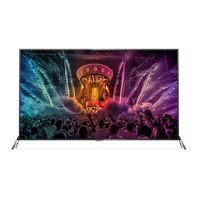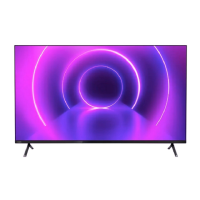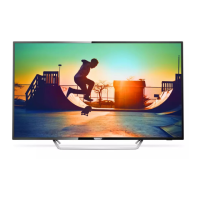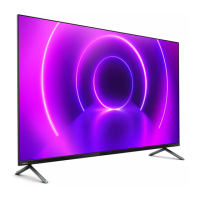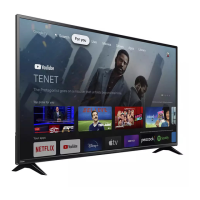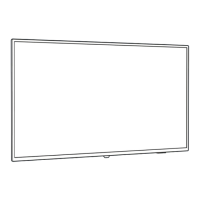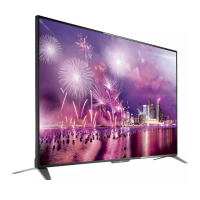Do you have a question about the Philips 65PUS7406 and is the answer not in the manual?
Explains the Home screen layout, channels, and content browsing.
Instructions on how to open and navigate the TV's Home screen.
Details new features and look of the Home launcher after an update.
Essential safety precautions to follow before using the TV.
Guidance on installing the TV stand and wall mount, including VESA specs.
Recommendations for optimal TV positioning for viewing.
Instructions for safely connecting the power cable.
How to connect an antenna cable to the TV for signal input.
Instructions for connecting a satellite dish to the TV.
Explanation of the main buttons on the remote control.
Details on the middle and bottom sections of the remote control buttons.
Info on the IR sensor and guidelines for cleaning the remote.
Instructions for replacing batteries in the remote control.
Guide to installing channels during the initial TV setup.
How to scan for digital or analogue channels.
Steps for installing satellite channels, including mode selection.
Procedures for re-scanning or manually tuning satellite channels.
Instructions for setting up a Unicable system for satellite connection.
Guide to installing channels via antenna connection.
Settings for RF scan, channel scan type, and store type.
How to skip unwanted channels from the list.
Options to sort or reorder channels in the list.
Editing channel details and fine-tuning analogue channels.
Procedures for updating channels automatically or manually.
How to manage update notifications.
Different methods for manually updating channels.
Information on watching TV channels and switching between them.
How to open, filter, and navigate channel lists.
Methods to find channels and sort the channel list.
Specific channel list operations for Freeview Play.
Instructions on tuning to channels and switching.
Setting parental ratings, blocking inputs, and managing PIN codes.
Creating and editing favourite channel lists for easy access.
General guidance on connecting devices with quality cables.
Using HDMI ARC for audio return and HDMI CEC for control.
Instructions for installing and using CI+ CAM modules and smart cards.
Setting and managing PIN codes for CAM channels.
Connecting Home Theatre Systems via HDMI ARC or optical audio.
Connecting video devices and setting up digital audio output.
Connecting headphones and using USB flash drives for media.
How to connect a computer and use the TV as a monitor.
What you need and how to pair Bluetooth devices.
Selecting, renaming, and removing paired Bluetooth devices.
Instructions for unpairing and removing a Bluetooth device.
Connecting the TV to your home network.
Steps for connecting via Wi-Fi or Ethernet cable.
Configuring network settings like proxy and IP.
How to sign in with your Google account for full features.
Overview of apps, installation from Google Play Store.
How to rent or buy movies and TV shows.
Using YouTube Music for audio and Google Play Games for entertainment.
Steps to install, start, stop, and manage apps.
How to switch between TV tuner and connected devices.
Adjusting picture settings and selecting picture modes.
Settings to adjust the picture aspect ratio and fill the screen.
Advanced picture adjustments like backlight, contrast, and sharpness.
Adjusting sound modes and other audio settings.
Managing sleep timers and power saving features.
Configuring audio languages and MHEG PIN protection.
Settings for HbbTV functionality and tracking.
Settings for teletext language and subtitle preferences.
Checking system information like signal level and frequency.
Managing device preferences like system updates and language.
Configuring Ambilight, Retail Mode, Google Assistant, and Chromecast.
Procedures for rebooting and factory resetting the TV.
Adjusting the clock and changing the menu language.
Activating special functions for hearing and visually impaired users.
How to view photos and play videos from a USB drive.
Options for sorting, copying, and deleting photos.
How to play music and preview text files from USB.
Information on where TV Guide data comes from.
How to open and navigate the TV Guide.
How to cast content from a mobile device to the TV.
Instructions for updating software locally or from the internet.
How to view the current TV software version.
Where to view open-source licenses for the TV software.
Information on the product's energy efficiency and disposal.
Details on power requirements and the operating system.
Specifications for TV reception standards and display types.
Details on TV connectivity ports and sound output.
Supported media containers, codecs, and subtitle formats.
Benefits and steps for registering your TV.
Resolving issues with power, remote control, channels, picture, and sound.
Resolving problems with HDMI, USB, Network, and Bluetooth.
Accessing online support and contacting for repair services.
General safety warnings to prevent hazards.
Specific warnings about electric shock, physical injury, and fire hazards.
Warnings about TV stability and risks associated with batteries.
Precautions against overheating, lightning strikes, and hearing damage.
Guidelines for operating the TV in different temperature and humidity conditions.
Instructions for safely cleaning and caring for the TV screen.
Information regarding HDMI trademarks and licensing.
Details on Dolby and DTS-HD trademarks and licensing.
Information on Wi-Fi Alliance and other relevant trademarks.
Explains the Home screen layout, channels, and content browsing.
Instructions on how to open and navigate the TV's Home screen.
Details new features and look of the Home launcher after an update.
Essential safety precautions to follow before using the TV.
Guidance on installing the TV stand and wall mount, including VESA specs.
Recommendations for optimal TV positioning for viewing.
Instructions for safely connecting the power cable.
How to connect an antenna cable to the TV for signal input.
Instructions for connecting a satellite dish to the TV.
Explanation of the main buttons on the remote control.
Details on the middle and bottom sections of the remote control buttons.
Info on the IR sensor and guidelines for cleaning the remote.
Instructions for replacing batteries in the remote control.
Guide to installing channels during the initial TV setup.
How to scan for digital or analogue channels.
Steps for installing satellite channels, including mode selection.
Procedures for re-scanning or manually tuning satellite channels.
Instructions for setting up a Unicable system for satellite connection.
Guide to installing channels via antenna connection.
Settings for RF scan, channel scan type, and store type.
How to skip unwanted channels from the list.
Options to sort or reorder channels in the list.
Editing channel details and fine-tuning analogue channels.
Procedures for updating channels automatically or manually.
How to manage update notifications.
Different methods for manually updating channels.
Information on watching TV channels and switching between them.
How to open, filter, and navigate channel lists.
Methods to find channels and sort the channel list.
Specific channel list operations for Freeview Play.
Instructions on tuning to channels and switching.
Setting parental ratings, blocking inputs, and managing PIN codes.
Creating and editing favourite channel lists for easy access.
General guidance on connecting devices with quality cables.
Using HDMI ARC for audio return and HDMI CEC for control.
Instructions for installing and using CI+ CAM modules and smart cards.
Setting and managing PIN codes for CAM channels.
Connecting Home Theatre Systems via HDMI ARC or optical audio.
Connecting video devices and setting up digital audio output.
Connecting headphones and using USB flash drives for media.
How to connect a computer and use the TV as a monitor.
What you need and how to pair Bluetooth devices.
Selecting, renaming, and removing paired Bluetooth devices.
Instructions for unpairing and removing a Bluetooth device.
Connecting the TV to your home network.
Steps for connecting via Wi-Fi or Ethernet cable.
Configuring network settings like proxy and IP.
How to sign in with your Google account for full features.
Overview of apps, installation from Google Play Store.
How to rent or buy movies and TV shows.
Using YouTube Music for audio and Google Play Games for entertainment.
Steps to install, start, stop, and manage apps.
How to switch between TV tuner and connected devices.
Adjusting picture settings and selecting picture modes.
Settings to adjust the picture aspect ratio and fill the screen.
Advanced picture adjustments like backlight, contrast, and sharpness.
Adjusting sound modes and other audio settings.
Managing sleep timers and power saving features.
Configuring audio languages and MHEG PIN protection.
Settings for HbbTV functionality and tracking.
Settings for teletext language and subtitle preferences.
Checking system information like signal level and frequency.
Managing device preferences like system updates and language.
Configuring Ambilight, Retail Mode, Google Assistant, and Chromecast.
Procedures for rebooting and factory resetting the TV.
Adjusting the clock and changing the menu language.
Activating special functions for hearing and visually impaired users.
How to view photos and play videos from a USB drive.
Options for sorting, copying, and deleting photos.
How to play music and preview text files from USB.
Information on where TV Guide data comes from.
How to open and navigate the TV Guide.
How to cast content from a mobile device to the TV.
Instructions for updating software locally or from the internet.
How to view the current TV software version.
Where to view open-source licenses for the TV software.
Information on the product's energy efficiency and disposal.
Details on power requirements and the operating system.
Specifications for TV reception standards and display types.
Details on TV connectivity ports and sound output.
Supported media containers, codecs, and subtitle formats.
Benefits and steps for registering your TV.
Resolving issues with power, remote control, channels, picture, and sound.
Resolving problems with HDMI, USB, Network, and Bluetooth.
Accessing online support and contacting for repair services.
General safety warnings to prevent hazards.
Specific warnings about electric shock, physical injury, and fire hazards.
Warnings about TV stability and risks associated with batteries.
Precautions against overheating, lightning strikes, and hearing damage.
Guidelines for operating the TV in different temperature and humidity conditions.
Instructions for safely cleaning and caring for the TV screen.
Information regarding HDMI trademarks and licensing.
Details on Dolby and DTS-HD trademarks and licensing.
Information on Wi-Fi Alliance and other relevant trademarks.
| Screen shape | Flat |
|---|---|
| Response time | - ms |
| Display diagonal | 65 \ |
| Display brightness | - cd/m² |
| Display technology | LED |
| Native aspect ratio | 16:9 |
| Native refresh rate | 60 Hz |
| Supported video modes | 1080p, 1440p, 2160p |
| Display diagonal (metric) | 164 cm |
| Screen format adjustments | 4:3, 16:9 |
| Supported graphics resolutions | 1920 x 1080 (HD 1080), 2560 x 1440, 3840 x 2160 |
| Motion interpolation technology | - |
| Tuner type | Analog & digital |
| Auto channel search | Yes |
| Analog signal format system | PAL, SECAM |
| Digital signal format system | DVB-C, DVB-S, DVB-S2, DVB-T, DVB-T2, DVB-T2 HD |
| Video apps | Amazon Prime Video, BBC iPlayer, Disney+, Netflix, YouTube |
| Operating system version | 10 (Q) |
| Operating system installed | Android |
| Audio decoders | Dolby Atmos |
| RMS rated power | 20 W |
| Number of speakers | 2 |
| Wi-Fi standards | 802.11b, 802.11g, Wi-Fi 4 (802.11n) |
| Bluetooth version | 5.0 |
| Product color | Black |
| Mercury content | 0 mg |
| Housing material | Plastic |
| Rollable display | No |
| Panel mounting interface | 200 x 200 mm |
| Audio formats supported | AAC, MP3, WAV, WMA, WMA-PRO |
| Image formats supported | BMP, GIF, HEIF, JPEG, PNG |
| Video formats supported | AVC, AVI, H.264, H.265, HEVC, MKV, MPEG1, MPEG2, MPEG4, VP9 |
| Subtitle formats supported | ASS, SMI, SRT, SSA, SUB, TXT |
| High Dynamic Range (HDR) technology | Dolby Vision, High Dynamic Range 10+ (HDR10 Plus), Hybrid Log-Gamma (HLG) |
| HDMI ports quantity | 4 |
| USB 2.0 ports quantity | USB 2.0 ports have a data transmission speed of 480 Mbps, and are backwards compatible with USB 1.1 ports. You can connect all kinds of peripheral devices to them. |
| Ethernet LAN (RJ-45) ports | 1 |
| USB 3.2 Gen 1 (3.1 Gen 1) Type-A ports quantity | 0 |
| Programming period | 8 day(s) |
| AC input voltage | 220 - 240 V |
| AC input frequency | 50 - 60 Hz |
| Energy efficiency scale | A to G |
| Power consumption (standby) | 2 W |
| Power consumption (typical) | - W |
| Cables included | AC |
| Package type | Box |
| Package depth | 170 mm |
| Package width | 1600 mm |
| Package height | 995 mm |
| Package weight | 27500 g |
| Stand depth | 289.3 mm |
|---|---|
| Stand width | 805.5 mm |
| Depth (with stand) | 305.6 mm |
| Width (with stand) | 1447.5 mm |
| Height (with stand) | 867.3 mm |
| Weight (with stand) | 20700 g |
| Depth (without stand) | 88 mm |
| Height (without stand) | 837.3 mm |
| Weight (without stand) | 20500 g |
